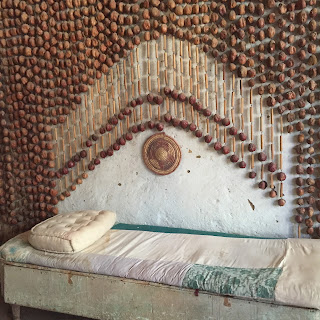SAILING THE NILE IN A DAHABYIA
OCTOBER 2015-PART 7
Last night we climbed up the embankment walked a dusty road past a few houses and fields of crops to take a 35 minute Mr. Toad’s Wild Ride into Aswan to go to the souk. Aswan is known for its spices and that is what was on the agenda for the night, but first we wandered through the very colorful and busy bazaar taking in all the sights and smells.
Aswan is the place where the Nubians were relocated when the high Aswan Dam was built and now live. They have their own traditions, dress, culture and even language. If you make the mistake and call one of them Egyptian, they are quick to proudly tell you they are Nubian. The traditional dress for a Nubian woman is a very colorful underdress over which is either a black lace or net overdress allowing the bright color to shine through. It is very elegant and eye-catching .
As we were preparing to take the van back to the boat Ahmed explained that the first driver had been drinking (thus the wild ride) so he told him not to bother coming to pick us up. Ahmed found us another van and driver - a local who picks up transport as he can. We climbed aboard are amused, when starting out of town, all of a sudden he drives to the other side of the road to say hello to friends. He also had a habit of honking his horn on a fairly regular basis. Then I noticed he was talking non-stop on his mobile phone. This means driving with one hand or no hands when shifting or honking. I was told he was speaking to his girlfriend to brag how he had a van full of tourists!!! I then said to Ahmed that driving and talking is as dangerous as driving drunk. With that the talking was over.
In the morning we sailed to another spot close to a Nubian Village outside of Aswan. This was market day and also a supposed camel market. First we stopped at the most amazing house.
 |
| Entrance To Nubian House |
 |
| Walking Through A Tunnel of Bamboo |
 |
| Ceiling of Dohm Pods Painted Red/Balck |
 |
| Wall Decoration Over A Bed |
 |
| Lacy Doorway |
 |
| Outdoor Pavilion |
 |
| Nubian Couple Faces |
The faces to the right show the headdress of the woman and the caps worn by the men. This one is white but they are usually bright colors and patterns.
Then we hunted for the camel market, but could only find an enclosure with about 15 subadult camels. Since motorization has become more the norm the camel trade
is dying out. Progress!!! Or is it????
 |
| All The Camels We Could Find |
We were truly in with the locals when wandering the souk. No tourists here and the goods on offer reflected that. It was also election day adding a bit more excitement to the visit. It was very peaceful, but active around the voting place. Tuk Tuks careened around the market along with motorbikes delivering goods and people. Gone are the days of donkey carts and horses loaded with goods as the norm. There are still a few, but not as before.
This was the last day on the Dahabyia. I had a flight back to Cairo while the rest of the group was to spend a bit more time in Aswan then board the train for Luxor where they will spend a few nights take in a few more sights, go hot air ballooning and when finished, board a plane from Luxor to Germany.
But first we sailed to the other side of the Nile where we bid farewell to our crew, boarded a van and drove out to where we caught a motorboat to take us to a place called Kalabsha.
This site has several temples that were rescued and relocated here when the High Aswan Dam was built and Lake Nassar created. It also has stones with petroglyphs from prehistoric times - a very rare find.
 |
| Approaching Kalabsha Temple In Boat |
 |
| Petroglyphs Similar To Wadi Rum in Jordan |
 |
| Can You See The Elephant? |
Kalabsha, the main, largest and most complete temple, was built in the Roman era during Augustus’s reign (about 30 BCE) to honor the lower Nubian sun god called
Mandulis. The temple was originally located about 50 km south of Aswan but was relocated in cooperation with Germany. When Christianity was introduced to Egypt, it was used as a church.
 |
| Sun god Mandulis |
A smaller temple built for Ramses II by his viceroy is called Beit-al-Wali dedicated to the god Amun. It has the typical scenes of fighting and conquering his enemies in this case Syrians, Libyans and Ethiopians. There are statues of Ramses II in miniature compared to other temples like Karnak and Abu Simbel.
 |
| Kirtassi |
The third temple, a skeleton called Kirtassi, is dedicated to Isis. Even though dedicated to Isis, it is famous for its two Hathor columns.
 |
| Close Up Of Hathor on Column Top |
Bidding farewell to Kalabsha we took the motorboat back climbed into the van, drove to the airport to drop me off and where there were farewell hugs all around. It was such a wonderful journey. I shall miss the laughter and the camaraderie.
Thanks for sailing with me on my Dahabyia Journey, now on to Sierra Leone!!!
Much Love To You All,
Sara/Mom/Grandma Syrup



























